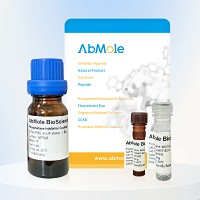All AbMole products are for research use only, cannot be used for human consumption.

Transferrin is iron-binding blood plasma glycoproteins that control the level of free iron in biological fluids. The function of Transferrin is to transport iron from the intestine, reticuloendothelial system, and liver parenchymal cells to all proliferating cells in the body. Transferrin is found in the mucosa and binds iron, thus creating an environment low in free iron that impedes bacteria survival in a process called iron withholding. The level of transferrin decreases in inflammation. Transports iron ions from the hemolymph into the eggs during the vitellogenic stage. Transferrins are iron binding transport proteins which can bind two Fe(3+) ions in association with the binding of an anion, usually bicarbonate.
The concentration of immobilized human transferrin (His tag) is 1ug/mL (100uL/well) and the linear binding range that can bind to human transferrin receptor (Fc tag) is 2-50 ng/mL.
Expression host is Human HEK293 cells
| Solubility (25°C) | Water Saline PBS |
| Storage | 2-8°C, dry, sealed |
| Related Cytokines and Growth Factors Products |
|---|
| Recombinant Human FGFR1 Protein (HEK293, C-His)
FGFR1, also known as CD331, is a full-length representative protein consists of an extracellular region, composed of three immunoglobulin-like domains, a single hydrophobic membrane-spanning segment and a cytoplasmic tyrosine kinase domain. |
| Recombinant Human FGFR2 Protein (HEK293, C-His)
FGFR2, also known as CD332, acts as cell-surface receptor for fibroblast growth factors and plays an essential role in the regulation of cell proliferation, differentiation, migration and apoptosis, and in the regulation of embryonic development. FGFR2 plays an essential role in the regulation of osteoblast differentiation, proliferation and apoptosis, and is required for normal skeleton development. It also promotes cell proliferation in keratinocytes and imature osteoblasts, but promotes apoptosis in differentiated osteoblasts. |
| Recombinant Mouse BMP-4 Protein (E. coli, C-His)
Bone Morphogenetic Protein-4 (BMP-4) is a critical signaling molecule required for the early differentiation of the embryo and establishing of a dorsal-ventral axis. BMP-4 is secreted from the dorsal portion of the notochord, and it acts in concert with sonic hedgehog to establish a dorsal-ventral axis for the differentiation of later structures. |
| Recombinant Human Coagulation Factor X (HEK293, C-Fc)
Coagulation factor X, belongs to the peptidase S1 family. Coagulation factor X is initially synthesized in the liver. Coagulation factor X is a vitamin K-dependent glycoprotein that converts prothrombin to thrombin in the presence of factor Va, calcium and phospholipid during blood clotting. |
| Recombinant Human FGF-8b Protein (E. coli)
Recombinant Human FGF-8b Protein is a heparin-binding growth factor, which plays a core role in prenatal development, postnatal growth and regeneration of various tissues by promoting cell proliferation and other effect. |
All AbMole products are for research use only, cannot be used for human consumption or veterinary use. We do not provide products or services to individuals. Please comply with the intended use and do not use AbMole products for any other purpose.


Products are for research use only. Not for human use. We do not sell to patients.
© Copyright 2010-2024 AbMole BioScience. All Rights Reserved.
